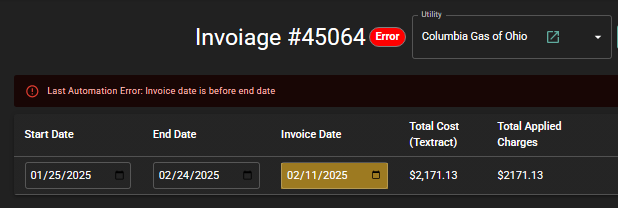How We Validate Bill Data

Ensuring accuracy and integrity is paramount when it comes to invoice data processing. Incorrect or estimated charges can add up to significantly increased expenses over time.
At Invoiage, we employ a series of heuristic validations to make sure the data you receive from every bill we process is correct, complete, and reflective of your actual usage.
9 Steps to Invoice Data Validation
Our meticulous process to validate bill data sets us apart from other companies, whose error-prone data requires manual correction.
Let’s take a look at how our system (and our people) validate bill data to ensure invoices come through accurately:
1. Ensure Charges Match Usage
One of the first things we check for is whether all the recorded usage matches the charges applied. If there’s usage data for a meter that doesn’t have corresponding charges, we flag this discrepancy. This ensures that every kilowatt-hour or cubic meter of usage you consume is correctly accounted for in your billing.
2. Zero Charges Check
Sometimes, a bill might come through where all charges are zero. Invoiage flags this as an error. This validation prevents issues where data may not have been processed correctly or where charges were inadvertently omitted.
3. Usage and Demand Validation
We verify that all of the requisite usage and demand data have been applied to your bill. If usage data is missing or if demand data isn’t present for meters that historically have billed for demand, the Invoiage system alerts us. This step is crucial for ensuring that your utility bill reflects all your energy consumption and peak usage.
4. Duplicate Usage Detection
Our systems are smart enough to spot if there are multiple entries for the same usage amount. This could happen due to data entry errors or system glitches, and we make sure to catch these to avoid overcharging or billing inaccuracies.
5. Total Charge Accuracy
We compare the total charges calculated from your bill details against multiple references like previous bill totals or OCR data from the actual bill images. If there’s a mismatch, we investigate further. This step ensures that the sum of all charges matches what should be billed based on actual usage.

6. Date Consistency Checks
Billing dates are critical. We check that the invoice date doesn’t come before the bill end date. We also ensure that the invoice date isn’t too far past the bill period, which could indicate delays or errors in billing.
7. Neighboring Bills and Thresholds
We look at historical data for consistency. If there’s no bill immediately before or after the current one, or if usage or demand deviates significantly from historical norms, these are potential signs of data issues or unusual usage patterns that warrant a closer look.

8. Delivery Cadence and Date Range Checks
Bills should follow a predictable pattern based on delivery cycles. If a bill’s period doesn’t fit this pattern or if there are multiple, conflicting date ranges, we flag these for review. This helps maintain consistency in billing cycles. Steps 6-8 are key to ensuring your data has no gaps in it.
9. Active Meter Status
There shouldn’t be any billing usage for a meter that’s supposed to be inactive. We verify the status of each utility account meter (UAM) to ensure we’re not billing for meters that aren’t in use, or that you as the client are choosing not to track data for.
Key Takeaways
These data validations are part of our commitment to accuracy, transparency, and customer trust. By running these in-depth checks, we ensure that your utility bills and other invoices are not just numbers but a true reflection of actual usage.
While this process might seem complex, it’s all done behind the scenes by our experienced team to provide you with peace of mind that your data is handled with precision and care.
Next Steps
Are you fed up with feeling like something is amiss with your utility or other bills? Does your current data supplier produce too many mistakes? We’re here to rigorously screen your invoices for accuracy, so you can confidently rely on the data we deliver. Get in touch to learn more.

